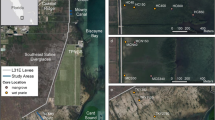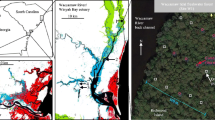Abstract
The distribution of mangrove biomass and forest structure along Shark River estuary in the Florida Coastal Everglades (FCE) has been correlated with elevated total phosphorus concentration in soils thought to be associated with storm events. The passage of Hurricane Wilma across Shark River estuary in 2005 allowed us to quantify sediment deposition and nutrient inputs in FCE mangrove forests associated with this storm event and to evaluate whether these pulsing events are sufficient to regulate nutrient biogeochemistry in mangrove forests of south Florida. We sampled the spatial pattern of sediment deposits and their chemical properties in mangrove forests along FCE sites in December 2005 and October 2006. The thickness (0.5 to 4.5 cm) of hurricane sediment deposits decreased with distance inland at each site. Bulk density, organic matter content, total nitrogen (N) and phosphorus (P) concentrations, and inorganic and organic P pools of hurricane sediment deposits differed from surface (0–10 cm) mangrove soils at each site. Vertical accretion resulting from this hurricane event was eight to 17 times greater than the annual accretion rate (0.30 ± 0.03 cm year−1) averaged over the last 50 years. Total P inputs from storm-derived sediments were equivalent to twice the average surface soil nutrient P density (0.19 mg cm−3). In contrast, total N inputs contributed 0.8 times the average soil nutrient N density (2.8 mg cm−3). Allochthonous mineral inputs from Hurricane Wilma represent a significant source of sediment to soil vertical accretion rates and nutrient resources in mangroves of southwestern Everglades. The gradient in total P deposition to mangrove soils from west to east direction across the FCE associated with this storm event is particularly significant to forest development due to the P-limited condition of this carbonate ecosystem. This source of P may be an important adaptation of mangrove forests in the Caribbean region to projected impacts of sea-level rise.





Similar content being viewed by others
References
Alongi, D.M. 2008. Mangrove forests: Resilience, protection from tsunamis, and responses to global climate change. Estuarine, Coastal and Shelf Science 76: 1–13.
Aspila, K.I., H. Agemian, and S.Y. Chau. 1976. A semi-automated method for the determination of inorganic, organic and total phosphate in sediments. Analyst 101: 187–197.
Cahoon, D.R. 2006. A review of major storm impacts on coastal wetland elevations. Estuaries and Coasts 29: 889–898.
Cahoon, D.R., and J.C. Lynch. 1997. Vertical accretion and shallow subsidence in a mangrove forest of southwestern Florida, U.S.A. Mangroves and Salt Marshes 1: 173–186.
Cahoon, D.R., D.J. Reed, J.W.J. Day, G.D. Steyer, R.M. Boumans, J.C. Lynch, D. McNally, and N. Latif. 1995. The influence of Hurricane Andrew on sediment distribution in Louisiana coastal marshes. Journal of Coastal Research 21: 280–294.
Cahoon, D.R., J.C. Lynch, and R.M. Knaus. 1996. Improved cryogenic coring device for sampling wetland soils. Journal of Sedimentary Research 66: 1025–1027.
Cahoon, D.R., P. Hensel, J. Rybczyk, K.L. McKee, E. Proffitt, and B.C. Perez. 2003. Mass tree mortality leads to mangrove peat collapse at Bay Islands, Honduras after Hurricane Mitch. Journal of Ecology 91: 1093–1105.
Callaway, J.C., J.A. Nyman, and R.D. DeLaune. 1996. Sediment accretion in coastal wetlands: A review and simulation model of processes. Current Topics in Wetland Biogeochemistry 2: 2–23.
Chambers, R.M., and K.A. Pederson. 2006. Variation in soil phosphorus, sulfur, and iron pools among south Florida wetlands. Hydrobiologia 569: 63–70.
Chen, R., and R.R. Twilley. 1999a. A simulation model of organic matter and nutrient accumulation in mangrove wetland soils. Biogeochemistry 44: 93–118.
Chen, R., and R.R. Twilley. 1999b. Patterns of mangrove forest structure and soil nutrient dynamics along the Shark River Estuary, Florida. Estuaries 22: 955–970.
Childers, D.L. 2006. A synthesis of long-term research by the Florida Coastal Everglades LTER Program. Hydrobiologia 569: 531–544.
Davies, B.E. 1974. Loss-on-ignition as an estimate of soil organic matter. Soil Science Society of American Proceedings 38: 150–151.
Davis, S.E., D.L. Childers, J.W. Day Jr., D.T. Rudnick, and F. Sklar. 2001. Nutrient dynamics in vegetated and unvegetated areas of a southern Everglades mangrove creek. Estuarine, Coastal and Shelf Science 52: 753–765.
Davis, S.E.I., J.E. Cable, D.L. Childers, C. Coronado-Molina, J.W.J. Day, C.D. Huttle, C.J. Madden, E. Reyes, D. Rudnick, and F. Sklar. 2004. Importance of storm events in controlling ecosystem structure and function in a Florida Gulf coast estuary. Journal of Coastal Research 20: 1198–1208.
Day, J.W.J., D.F. Boesch, E.J. Clairain, G.P. Kemp, S.B. Laska, W.J. Mitsch, K. Orth, H. Mashriqui, D.J. Reed, L. Shabman, C.A. Simenstad, B.J. Streever, R.R. Twilley, C.C. Watson, J.T. Wells, and D.F. Whigham. 2007. Restoration of the Mississippi Delta: Lessons from Hurricanes Katrina and Rita. Science 315: 1679–1684.
Duever, M.J., J.F. Meeder, L.C. Meeder, and J.M. McCollom. 1994. The climate of South Florida and its role in shaping the Everglades ecosystem. In Everglades: The ecosystem and its restoration, ed. S.M. Davis, and J.C. Ogden, 225–248. Delray Beach: St. Lucie.
Ewe, S.M.L., E.E. Gaiser, D.L. Childers, D. Iwaniec, V. Rivera-Monroy, and R.R. Twilley. 2006. Spatial and temporal patterns of aboveground net primary productivity (ANPP) along tow freshwater-estuarine transects in the Florida Coastal Everglades. Hydrobiologia 569: 459–474.
Fourqurean, J.W., J.C. Zieman, and G.V.N. Powell. 1992. Phosphorus limitation of primary production in Florida Bay: Evidence from C:N:P ratios of the dominant seagrass Thalassia testudinum. Limnology and Oceanography 37: 162–171.
Gentry, R.C. 1974. Hurricanes in South Florida. I. In Environments of South Florida: Present and past, ed. P.J. Gleason. Miami: Miami Geologic Society.
Gilman, E., J. Ellison, and R. Coleman. 2007. Assessment of mangrove response to projected relative sea-level rise and recent historical reconstruction of shoreline position. Environmental Monitoring and Assessment 124: 105–130.
Hedley, M.J., J.W.B. Stewart, and B.S. Chauhan. 1982. Changes in inorganic and organic soil phosphorus fractions induced by cultivation practices and by laboratory incubations. Soil Science Society of America Journal 46: 970–976.
Herbert, D.A., and J.W. Fourqurean. 2009. Phosphorus availability and salinity control productivity and demography of the seagrass Thalassia testudinum in Florida Bay. Estuaries and Coasts 32: 188–201.
Kenward, M., and Roger, J. 1997. Small sample inference for fixed effects from restricted maximum likelihood. Biometrics 53: 983–997.
Koch, M.S. 1997. Rhizophora mangle L. seedling development into sapling stage across resource and stress gradients in subtropical Florida. Biotropica 29: 427–439.
Krauss, K.W., T.W. Doyle, R.R. Twilley, and T.J.I. Smith. 2005. Woody debris in the mangrove forests of south Florida. Biotropica 37: 9–15.
Lajtha, K., C.T. Driscoll, W.M. Jarrel, and E.T. Elliot. 1999. Soil phosphorus characterization and total element analysis. In Standard soil methods for long-term ecological research, ed. G.P. Robertson, D.C. Coleman, C.S. Bledsoe, and P. Sollins, 115–142. New York: Oxford University Press.
Lodge, T.E. 2005. The everglades handbook: Understanding the ecosystem, 2nd ed. Boca Raton: CRC.
Lodge, D.J., and W.H. McDowell. 1991. Summary of ecosystem-level effects of Caribbean hurricanes. Biotropica 23: 373–378.
Lugo, A.E. 2000. Effects and outcomes of Caribbean hurricanes in a climatic change scenario. Science of the Total Environment 262: 243–251.
Lugo, A.E. 2008. Visible and invisible effects of hurricanes on forest ecosystems: An international review. Austral Ecology 33: 368–398.
Lynch, J.C., J.R. Meriwether, B.A. McKee, F. Vera-Herrera, and R.R. Twilley. 1989. Recent accretion in mangrove ecosystems based on 137Cs and 210Pb. Estuaries 12: 284–299.
McKee, K.L., D.R. Cahoon, and I.C. Feller. 2007. Caribbean mangroves adjust to rising sea level through biotic controls on change in soil elevation. Global Ecology and Biogeography 16: 545–556.
Michener, W.K., E.R. Blood, K.L. Bildstein, M.M. Brinson, and L.R. Gardner. 1997. Climatic change, hurricanes and tropical storms, and rising sea level in coastal wetlands. Ecological Applications 7: 770–801.
Noe, G.B., D.L. Childers, and R.D. Jones. 2001. Phosphorus biogeochemistry and the impact of phosphorus enrichment: Why is the Everglades so unique? Ecosystems 4: 603–624.
Nyman, J.A., C.R. Crozier, and R.D. DeLaune. 1995. Roles and patterns of hurricane sedimentation in an estuarine marsh landscape. Estuarine, Coastal and Shelf Science 40: 665–679.
Parkinson, R.W., R.D. DeLaune, and J.R. White. 1994. Holocene sea-level rise and the fate of mangrove forests in the Wider Caribbean region. Journal of Coastal Research 10: 1077–1086.
Pasch, R.J., E.S. Blake, H.D. Cobb, and D.P. Roberts. 2006. Tropical cyclone report Hurricane Wilma. National Weather Service. National Hurricane Center, http://www.nhc.noaa.gov., Miami, Florida.
Piou, C., I.C. Feller, U. Berger, and F. Chi. 2006. Zonation patterns of Belizean offshore mangrove forests 41 years after a catastrophic hurricane. Biotropica 38: 365–374.
Reddy, K.R., and R.D. DeLaune. 2008. Biogeochemistry of wetlands: Science and applications. Boca Raton: CRC.
Risi, J.A., H.R. Wanless, L.P. Tedesco, and S. Gelsanliter. 1995. Catastrophic sedimentation from Hurricane Andrew along the southwest Florida coast. Journal of Coastal Research 21: 83–102.
Sherman, R.E., T.J. Fahey, and P. Martinez. 2001. Hurricane impacts on a mangrove forest in the Dominican Republic: Damage patterns and early recovery. Biotropica 33: 393–408.
Simard, M., K. Zhang, V. Rivera-Monroy, M.S. Ross, P.L. Ruiz, E. Castañeda-Moya, R.R. Twilley, and E. Rodriguez. 2006. Mapping height and biomass of mangrove forests in Everglades National Park with SRTM elevation data. Photogrammetric Engineering and Remote Sensing 72: 299–311.
Smith, T.J.I., M.B. Robblee, H.R. Wanless, and T.W. Doyle. 1994. Mangroves, hurricanes, and lightning strikes. BioScience 44: 256–262.
Smith, T.J.I., G.H. Anderson, K. Balentine, G. Tiling, G.A. Ward, and K.R.T. Whelan. 2009. Cumulative impacts of hurricanes on Florida mangrove ecosystems: Sediment deposition, storm surges and vegetation. Wetlands 29: 24–34.
Sutula, M. 1999. Processes controlling nutrient transport in the southeastern Everglades wetlands. Ph.D. Dissertation. Louisiana State University, Baton Rouge.
Turner, R.E., E.M. Swenson, C.S. Milan, and J.M. Lee. 2007. Hurricane signals in salt marsh sediments: Inorganic sources and soil volume. Limnology and Oceanography 52: 1231–1238.
Twilley, R.R., and V. Rivera-Monroy. 2005. Developing performance measures of mangrove wetlands using simulation models of hydrology, nutrient biogeochemistry, and community dynamics. Journal of Coastal Research 40: 79–93.
Wanless, H.R., R.W. Parkinson, and L.P. Tedesco. 1994. Sea level control on stability of Everglades wetlands. In Everglades. The ecosystem and its restoration, ed. S.M. Davis, and J.C. Ogden, 199–223. Delray Beach: St. Lucie.
Webster, P.J., G.J. Holland, J.A. Curry, and H.R. Chang. 2005. Changes in tropical cyclone number, duration, and intensity in a warming environment. Science 309: 1844–1846.
Whelan, K.R.T., T.J.I. Smith, D.R. Cahoon, J.C. Lynch, and G.H. Anderson. 2005. Groundwater control of mangrove surface elevation: Shrink and swell varies with soil depth. Estuaries 28: 833–843.
Whelan, K.R.T., T.J.I. Smith, G.H. Anderson, and M.L. Ouellette. 2009. Hurricane Wilma’s impact on overall soil elevation and zones within the soil profile in a mangrove forest. Wetlands 29: 16–23.
Zhang, K., M. Simard, M.S. Ross, V. Rivera-Monroy, P. Houle, P.L. Ruiz, R.R. Twilley, and K.R.T. Whelan. 2008. Airborne laser scanning quantification of disturbances from hurricanes and lightning strikes to mangrove forests in Everglades National Park, USA. Sensors 8: 2262–2292.
Acknowledgments
This research was conducted as part of the Florida Coastal Everglades Long-Term Ecological Research (FCE-LTER) program funded by the National Science Foundation (Grants #DBI-0620409 and #DEB-9910514). We would like to thank Jennifer Overton, Matthew Heels, Leander J. Lavergne, and Peter Lenaker for laboratory assistance. Special thanks to the Florida Bay Interagency Science Center-Everglades National Park for logistic support during the study. The authors thank John W. Day Jr., John R. White, Brian Marx, Charles Johnson, and two anonymous reviewers for constructive comments on earlier versions of this manuscript.
Author information
Authors and Affiliations
Corresponding author
Rights and permissions
About this article
Cite this article
Castañeda-Moya, E., Twilley, R.R., Rivera-Monroy, V.H. et al. Sediment and Nutrient Deposition Associated with Hurricane Wilma in Mangroves of the Florida Coastal Everglades. Estuaries and Coasts 33, 45–58 (2010). https://doi.org/10.1007/s12237-009-9242-0
Received:
Revised:
Accepted:
Published:
Issue Date:
DOI: https://doi.org/10.1007/s12237-009-9242-0




